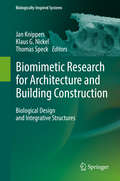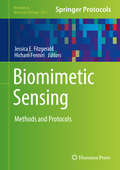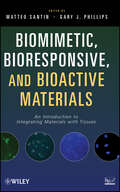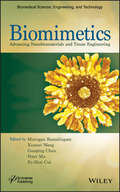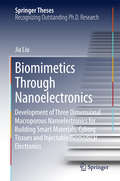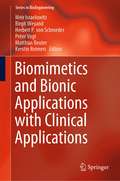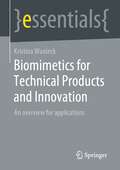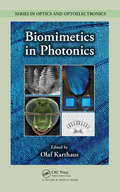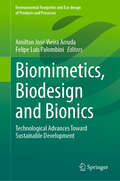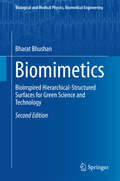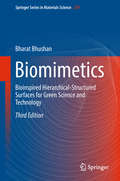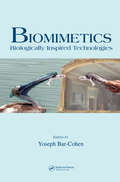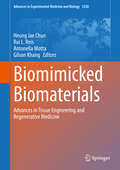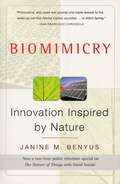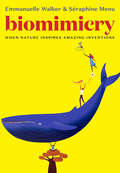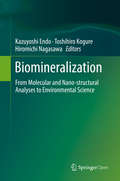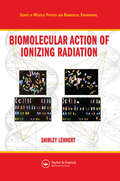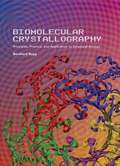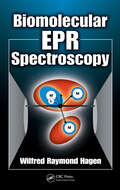- Table View
- List View
Biomimetic Research for Architecture and Building Construction: Biological Design and Integrative Structures (Biologically-Inspired Systems #8)
by Jan Knippers Klaus G. Nickel Thomas SpeckThis book comprises a first survey of the Collaborative Research Center SFB-TRR 141 'Biological Design and Integrative Structures - Analysis, Simulation and Implementation in Architecture', funded by the Deutsche Forschungsgemeinschaft since October 2014. The SFB-TRR 141 provides a collaborative framework for architects and engineers from the University of Stuttgart, biologists and physicists from the University of Freiburg and geoscientists and evolutionary biologists from the University of T#65533;bingen. The programm is conceptualized as a dialogue between the disciplines and is based on the belief that that biomimetic research has the potential to lead everyone involved to new findings far beyond his individual reach. During the last few decades, computational methods have been introduced into all fields of science and technology. In architecture, they enable the geometric differentiation of building components and allow the fabrication of porous or fibre-based materials with locally adjusted physical and chemical properties. Recent developments in simulation technologies focus on multi-scale models and the interplay of mechanical phenomena at various hierarchical levels. In the natural sciences, a multitude of quantitative methods covering diverse hierarchical levels have been introduced. These advances in computational methods have opened a new era in biomimetics: local differentiation at various scales, the main feature of natural constructions, can for the first time not only be analysed, but to a certain extent also be transferred to building construction. Computational methodologies enable the direct exchange of information between fields of science that, until now, have been widely separated. As a result they lead to a new approach to biomimetic research, which, hopefully, contributes to a more sustainable development in architecture and building construction.
Biomimetic Sensing: Methods and Protocols (Methods in Molecular Biology #2027)
by Jessica E. Fitzgerald Hicham FenniriThis book highlights the potential of e-device technology to serve as a successful platform for multiplexed sensing, along with the methods for device fabrication, calibration, and assays in multiple applications. The subsequent sections describe e-device sensing platforms, explore their use, and outline existing limitations and future directions in device development. This work mainly focuses on optical and electrochemical methods of sensing, as these are at the forefront of e-device technology, while also addressing cutting-edge mechanochemical sensing and methods to optimize e-device data and technology via drift correction and calibration and computer modelling. Written for the highly successful Methods in Molecular Biology series, chapters include introductions to their respective topics, lists of the necessary materials, step-by-step, readily reproducible laboratory protocols, and tips on troubleshooting and avoiding known pitfalls. Authoritative and practical, Biomimetic Sensing: Methods and Protocols is an ideal guide for researchers working in a wide variety of fields with a desire to utilize this inexpensive and less specialized technology in their studies.
Biomimetic, Bioresponsive, and Bioactive Materials
by Matteo Santin Gary J. PhillipsThe accessible introduction to biomaterials and their applications in tissue replacement, medical devices, and more Molecular and cell biology is being increasingly integrated into the search for high-performance biomaterials and biomedical devices, transforming a formerly engineering- and materials science-based field into a truly interdisciplinary area of investigation. Biomimetic, Bioresponsive, and Bioactive Materials presents a comprehensive introduction to biomaterials, discussing how they are selected, designed, and modified for integration with living tissue and how they can be utilized in the development of medical devices, orthopedics, and other related areas. Examining the physico chemical properties of widely used biomaterials and their uses in different clinical fields, the book explores applications including soft and hard tissue replacement; biointeractive metals, polymers, and ceramics; and in vitro, in vivo, and ex vivo biocompatibility tests and clinical trials. The book critically assesses the clinical level of research in the field, not only presenting proven research, but also positing new avenues of exploration. Biomimetic, Bioresponsive, and Bioactive Materials contains everything needed to get a firm grasp on materials science, fast. Written in an accessible style and including practice questions that test comprehension of the material covered in each chapter, the book is an invaluable tool for students as well as professionals new to the field.
Biomimetics
by Murugan Ramalingam Guoping Chen Peter Ma Fu-Zhai Cui Xiumei WangThis book compiles all aspects of biomimetics from fundamental principles to current technological advances and their future trends in the development of nanoscale biomaterials and tissue engineering. The scope of this book is principally confined to biologically-inspired design of materials and systems for the development of next generation nanobiomaterials and tissue engineering. The book addresses the state-of-the-art of research progress in the applications of the principles, processes, and techniques of biomimetics. The prospective outcomes of current advancements and challenges in biomimetic approaches are also presented.
Biomimetics Through Nanoelectronics: Development of Three Dimensional Macroporous Nanoelectronics for Building Smart Materials, Cyborg Tissues and Injectable Biomedical Electronics (Springer Theses)
by Jia LiuThis thesis presents original research on how to seamlessly integrate electronics with living biological systems. Jia Liu has used silicon nanowires as active sensors to investigate biological signals at the cellular level. He has also designed nanoelectronic networks into flexible, three-dimensional (3D) and macroporous architectures, which mimic the structure of tissue scaffolds for in vitro 3D integrations with synthetic tissues and in vivo implantation by means of syringe injection. Importantly, the results demonstrate 3D interpenetrations of nanoelectronic networks with neural networks, 3D mapping of tissue activity and long-term implantation with minimal immunoresponses. Further, the book discusses potential applications for pharmacological studies, brain activity mapping and nanoelectronics enabled therapies. The findings presented here have gained wide recognition, including a top research ranking by Chemical & Engineering News and being listed among Scientific American's 10 world changing ideas in 2015.
Biomimetics and Bionic Applications with Clinical Applications (Series in BioEngineering)
by Birgit Weyand Meir Israelowitz Herbert P. von Schroeder Peter Vogt Matthias Reuter Kerstin ReimersThis book presents current trends and developments in the rapidly growing field of biomimetics. It takes an application-oriented approach to reflect the interdisciplinary nature of this field: Experts, from academic as well as professional backgrounds, contribute to this book by describing and presenting state-of-the-art experiments and practical developments. A strong emphasis is put on the various possibility to apply biomimetics in tissue engineering, regenerative surgery, neurosurgery for clinical applications.
Biomimetics for Architecture & Design: Nature - Analogies - Technology
by Göran Pohl Werner NachtigallThis book provides the readers with a timely guide to the application of biomimetic principles in architecture and engineering design. As a result of a combined effort by two internationally recognized authorities, the biologist Werner Nachtigall and the architect Göran Pohl, the book describes the principles which can be used to compare nature and technology, and at the same time it presents detailed explanations and examples showing how biology can be used as a source of inspiration and "translated" in building and architectural solutions (biomimicry). Even though nature cannot be directly copied, the living world can provide architects and engineers with a wealth of analogues and inspirations for their own creative designs. But how can analysis of natural entities give rise to advanced and sustainable design? By reporting on the latest bionic design methods and using extensive artwork, the book guides readers through the field of nature-inspired architecture, offering an extraordinary resource for professional architects, engineers, designers and urban planners, as well as for university teachers, researchers and students. Natural evolution is seen throughout the book as a powerful resource that can serve architecture and design by providing innovative, optimal and sustainable solutions.
Biomimetics for Technical Products and Innovation: An overview for applications (essentials)
by Kristina WanieckBionics transfers knowledge about biological models into technical applications and can thus be used for the development of technical products and innovations. It is one of the most exciting approaches for future technical and social innovation, since most of the knowledge from biology has not yet been used. In this essential, Kristina Wanieck summarizes the most important basics of bionics for their application in practice. In addition, the author describes an approach that is open to topics and problems - i.e. independent of a specific question. These basics should make it possible to use bionics for a wide variety of questions and projects.This book is a translation of the original German 1st edition Bionik für technische Produkte und Innovation by Kristina Wanieck, published by Springer Fachmedien Wiesbaden GmbH, part of Springer Nature in 2019. The translation was done with the help of artificial intelligence (machine translation by the service DeepL.com). A subsequent human revision was done primarily in terms of content, so that the book will read stylistically differently from a conventional translation. Springer Nature works continuously to further the development of tools for the production of books and on the related technologies to support the authors.
Biomimetics in Photonics (Series in Optics and Optoelectronics)
by Olaf KarthausBiomimetic photonics is a burgeoning field. Biologists are finding and describing a whole menagerie of unique and astonishingly complex nano- and microstructures in fauna and flora. Material scientists are developing novel multifunctional and hierarchical structures with a wide variety of post-nano era photonics applications. Mathematicians and com
Biomimetics, Biodesign and Bionics: Technological Advances Toward Sustainable Development (Environmental Footprints and Eco-design of Products and Processes)
by Felipe Luis Palombini Amilton José Vieira ArrudaNature is a vast source of inspiration and information for the resolution of complex problems and can influence many varieties of design. Biomimetics, biodesign and bionics are three branches of interdisciplinary research merging biological and applied sciences. This volume collects cases that highlight recent breakthroughs in these disciplines. Biological features such as patterns, shapes, mechanisms, colors, structures, and more can be analyzed, organized, and modeled for application in human creations. Therefore, design, engineering, and architecture projects can benefit from solutions that were already tested and verified through evolution in the natural world. With the development of new technologies for the investigation, simulation, and testing of natural features, the path from nature to product can be accelerated. The cases presented in this work showcase how technological advancements are leading to improved design solutions and influencing our very comprehension of natureand its complex organization.
Biomimetics: Bioinspired Hierarchical-Structured Surfaces for Green Science and Technology (Biological and Medical Physics, Biomedical Engineering)
by Bharat BhushanThis book presents an overview of the general field of biomimetics - lessons from nature. It presents various examples of biomimetics, including roughness-induced superomniphobic surfaces which provide functionality of commercial interest. The major focus in the book is on lotus effect, rose petal effect, shark skin effect, and gecko adhesion. For each example, the book first presents characterization of an object to understand how a natural object provides functionality, followed by modeling and then fabrication of structures in the lab using nature's route to verify one's understanding of nature and provide guidance for development of optimum structures. Once it is understood how nature does it, examples of fabrication of optimum structures using smart materials and fabrication techniques, are presented. Examples of nature inspired objects are also presented throughout.
Biomimetics: Bioinspired Hierarchical-Structured Surfaces for Green Science and Technology (Biological and Medical Physics, Biomedical Engineering)
by Bharat BhushanThis book presents an overview of the general field of biomimetics - lessons from nature. It presents various examples of biomimetics, including roughness-induced superomniphobic surfaces which provide functionality of commercial interest. The major focus in the book is on lotus effect, rose petal effect, shark skin effect, and gecko adhesion. For each example, the book first presents characterization of an object to understand how a natural object provides functionality, followed by modeling and then fabrication of structures in the lab using nature’s route to verify one’s understanding of nature and provide guidance for development of optimum structures. Once it is understood how nature does it, examples of fabrication of optimum structures using smart materials and fabrication techniques, are presented. Examples of nature inspired objects are also presented throughout.
Biomimetics: Biologically Inspired Technologies
by Yoseph Bar-CohenNature is the world's foremost designer. With billions of years of experience and boasting the most extensive laboratory available, it conducts research in every branch of engineering and science. Nature's designs and capabilities have always inspired technology, from the use of tongs and tweezers to genetic algorithms and autonomous legged robots.
Biomimetics: Nature-Based Innovation (Biomimetics Series)
by Yoseph Bar-CohenMimicking nature - from science fiction to engineering realityHumans have always looked to nature's inventions as a source of inspiration. The observation of flying birds and insects leads to innovations in aeronautics. Collision avoidance sensors mimic the whiskers of rodents. Optimization algorithms are based on survival of the fittest, the seed-
Biomimetics: Nature-Inspired Design and Innovation
by Sandy B. PrimroseProvides a professional, contemporary, and concise review of the current knowledge and advances in biomimetics This book covers the field of biomimicry, an area of science where researchers look to mimic aspects of plants or animals in order to solve problems in aerospace, shipping, building, electronics, and optics, among others. It presents the latest developments in biomimicry and gives readers sufficient grounding to help them understand the current, and sometimes technically complex, research literature. Different themes are covered throughout and text boxes deal with the relevant physics for readers who may lack this knowledge. Biomimetics: Nature-Inspired Design and Innovation examines issues in fluid dynamics such as avoiding sonic booms, reducing train noise, increasing wind turbine efficiency, and more. Next, it looks at optical applications, e.g. how nature generates color without dyes and pigment, and how animals stay cool in desert environments. A chapter on the built environment discusses cooling systems for buildings based on termite mounds; creating self-cleaning paint based on lotus leaves; unobtrusive solar panels based on ivy; and buildings that respond to the environment. Two more sections focus on biomimicry for the creation of smart materials and smart devices. The book finishes with a look at the field’s future over the next decade. Presents each topic in sufficient detail in order to enable the reader to comprehend the original scientific papers Emphasizes those examples of biomimicry that have made it into products Features text boxes that provide information on the relevant physics or engineering principles for biologists who do not have a physics background Covers the scientific literature up to July 2019 Biomimetics: Nature-Inspired Design and Innovation is an excellent book for senior undergraduates and post-graduate students in the life sciences, material sciences, and bioengineering. It will also appeal to lay readers with an interest in nature as well as scientists in general.
Biomimicked Biomaterials: Advances in Tissue Engineering and Regenerative Medicine (Advances in Experimental Medicine and Biology #1250)
by Rui L. Reis Heung Jae Chun Gilson Khang Antonella MottaThis book is the second of two volumes that together offer a comprehensive account of cutting-edge advances in the development of biomaterials for use within tissue engineering and regenerative medicine. In this volume, which is devoted to biomimetic biomaterials, the opening section discusses bone regeneration by means of duck’s feet-derived collagen scaffold and the use of decellularized extracellular matrices. The role of various novel biomimetic hydrogels in regenerative medicine is then considered in detail. The third section focuses on the control of stem cell fate by biomimetic biomaterials, covering exosome-integrated biomaterials for bone regeneration, cellular responses to materials for biomedical engineering, and the regulation of stem cell functions by micropatterned structures. Finally, the use of nano-intelligent biocomposites in regenerative medicine is addressed, with discussion of, for example, recent advances in biphasic calcium phosphate bioceramics and blood-contacting polymeric biomaterials. The authors are recognized experts in the interdisciplinary field of regenerative medicine and the book will be of value for all with an interest in regenerative medicine based on biomaterials.
Biomimicry
by Janine M. BenyusThis profound and accessible book details how science is studying nature's best ideas to solve our toughest 21st-century problems. If chaos theory transformed our view of the universe, biomimicry is transforming our life on Earth. Biomimicry is innovation inspired by nature - taking advantage of evolution's 3.8 billion years of R&D since the first bacteria. Biomimics study nature's best ideas: photosynthesis, brain power, and shells - and adapt them for human use. They are revolutionising how we invent, compute, heal ourselves, harness energy, repair the environment, and feed the world. Science writer and lecturer Janine Benyus names and explains this phenomenon. She takes us into the lab and out in the field with cutting-edge researchers as they stir vats of proteins to unleash their computing power; analyse how electrons zipping around a leaf cell convert sunlight into fuel in trillionths of a second; discover miracle drugs by watching what chimps eat when they're sick; study the hardy prairie as a model for low-maintenance agriculture; and more.
Biomimicry: When Nature Inspires Amazing Inventions
by Seraphine MenuNature did it first! A beautiful and whimsically illustrated explanation of cool inventions like Velcro and scuba suits that were inspired by the natural worldDiscover how bats led to the development of radar, whales inspired the pacemaker, and the lotus flower may help us produce indestructible clothing. "Biomimicry" comes from the Greek "bio" (life) and "mimesis" (imitation)." Here are various and amazing ways that nature inspires us to create cool inventions in science and medicine, clothing design, and architecture. From the fireflies that showed inventors how LEDs could give off more light to the burdock plant that inspired velcro to the high speed trains of Japan that take the form of a kingfisher's sleek, aerodynamic head, there are innumerable ways that we can create smarter, better, safer inventions by observing the natural world. Author Seraphine Menu and illustrator Emmanuelle Walker also gently explain that our extraordinary, diverse, and awe-inspiring world is like a carefully calibrated machine and its fragile balance must be treated with extreme care and respect. "Go outside," they say, "observe, compare, and maybe some day you'll be the next person to be struck by a great idea."
Biomineralization Sourcebook: Characterization of Biominerals and Biomimetic Materials
by Laurie B. Gower Elaine DiMasiWhat does it mean to be at the forefront of a characterization technique? Novel implementation and research, finding new ways to visualize composites, and new techniques all play a role. Yet with the myriad of advances in the field, keeping up with new and advanced techniques, often from many different areas, has become a challenge. Biomineralizati
Biomineralization: From Molecular and Nano-structural Analyses to Environmental Science
by Kazuyoshi Endo Toshihiro Kogure Hiromichi NagasawaThis open access book is the proceedings of the 14th International Symposium on Biomineralization (BIOMIN XIV) held in 2017 at Tsukuba. Over the past 45 years, biomineralization research has unveiled details of the characteristics of the nano-structure of various biominerals; the formation mechanism of this nano-structure, including the initial stage of crystallization; and the function of organic matrices in biominerals, and this knowledge has been applied to dental, medical, pharmaceutical, materials, agricultural and environmental sciences and paleontology. As such, biomineralization is an important interdisciplinary research area, and further advances are expected in both fundamental and applied research.
Biomining Technologies: Extracting and Recovering Metals from Ores and Wastes
by Michael Schlömann David Barrie Johnson Christopher George Bryan Francisco Figueroa RobertoThis book describes emerging and established industrial processes of biomining technologies used for the recovery of metals of economic interest from, e.g. mineral ores, mining and electronic wastes using microbiological technologies. Multiple chapters focus on engineering design and operation of biomining systems. Several industrial case studies from China, Chile, Peru, Russia/Kazakhstan and Finland are included, which emphasises the practical approach of the book. The reader not only learns more about the biology, diversity and ecology of microorganisms involved in biomining processes, but also about microbial biomolecular and cultivation tools used in the biomining industry. Special emphasis is put on emerging biotechnologies enabling the use of biomining for recycling metals from e-wastes, waste streams and process waters. Finally, the future impacts and direction of biomining towards sustainability in a metal-demanding world are also highlighted.The book is aimed at an interdisciplinary audience involving operators and researchers working across disciplines including geology, chemical engineering, microbiology and molecular biology. This is reflected by the content of this book, as well as by its authors, who are all leading practitioners and authorities in their fields.
Biomolecular Action of Ionizing Radiation (Series in Medical Physics and Biomedical Engineering)
by Shirley LehnertEmbracing the transformation of radiation sciences by the recent surge of developments in molecular biology, this progressive text offers an up-to-date analysis of in vitro and in vivo molecular responses in the body induced by ionizing radiation. With a unique emphasis on medical physics applications, Biomolecular Action of Ionizi
Biomolecular Crystallography: Principles, Practice, and Application to Structural Biology
by Bernhard RuppSynthesizing over thirty years of advances into a comprehensive textbook, Biomolecular Crystallography describes the fundamentals, practices, and applications of protein crystallography. Illustrated in full-color by the author, the text describes mathematical and physical concepts in accessible and accurate language. Biomolecular Crystallography will be a valuable resource for advanced undergraduate and graduate students and practitioners in structural biology, crystallography, and structural bioinformatics.
Biomolecular EPR Spectroscopy
by Wilfred Raymond HagenComprehensive, Up-to-Date Coverage of Spectroscopy Theory and its Applications to Biological SystemsAlthough a multitude of books have been published about spectroscopy, most of them only occasionally refer to biological systems and the specific problems of biomolecular EPR (bioEPR). Biomolecular EPR Spectroscopy provides a practical introduction t
